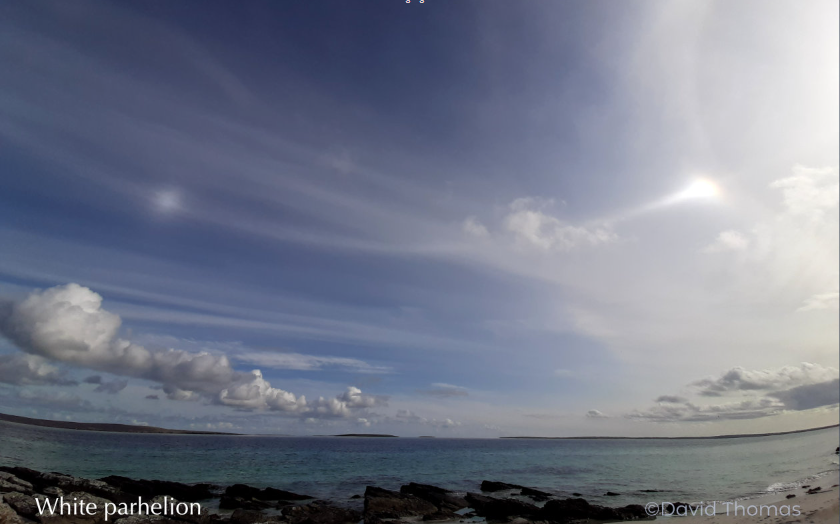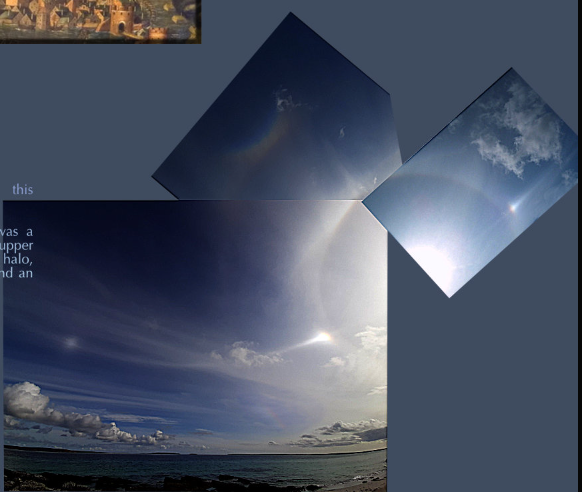120 degree white parhelion, Orkney Islands, Scotland
The Enigmatic 120 Degree White Parhelion in the Orkney Islands, Scotland
Have you ever witnessed a rare atmospheric phenomenon that left you in awe? Imagine gazing at the sky above the picturesque Orkney Islands in Scotland and spotting a captivating display of light known as the 120 degree white parhelion. This elusive optical phenomenon, which occurred over Egilsay, was observed by David Thomas and lasted for an impressive 20 minutes. Let's delve into the details of this mesmerizing event and explore the science behind it.
Unveiling the 120 Degree White Parhelion
The 120 degree white parhelion is a rare sight due to its low visibility against clouds and its formation from unique crystals. Unlike its more familiar counterpart, the 22 degree parhelion or sundog, the 120 degree parhelion is colorless and appears as a bright patch to the left of the sun. It is intricately linked to the 22 degree parhelion by the parhelic circle, forming a remarkable celestial connection.
The Path of Sunlight and Unusual Crystals
To understand the formation of the 120 degree white parhelion, we must delve into the path sunlight takes and the crystals involved. Sunlight enters the tops of horizontal plate crystals and undergoes two reflections from their vertical side faces before leaving through the lower face. This intricate process of refractions and internal reflections results in a ray deviated in azimuth by precisely 120 degrees. Additionally, there is no separation of colors in this phenomenon, contributing to its colorless appearance.
Thick Plate Crystals: The Key to Controlled Ray Path
One fascinating aspect of the 120 degree white parhelion is that unusually thick plate crystals are more likely to facilitate its formation. These crystals allow for a controlled path of rays, enhancing the visibility and distinctness of this atmospheric spectacle.
A Glimpse into History: The Vadersolstavlan Painting
The allure of the 120 degree parhelion extends beyond its rarity in the sky. This captivating phenomenon is immortalized in the world-renowned Vadersolstavlan painting displayed in Stockholm Cathedral. Created on April 20, 1535, this masterpiece accurately portrays halos and features two of the "6 suns," including the 120 degree parhelion. The painting serves as a testament to the enduring fascination humans have held for atmospheric optics throughout history.
A Composite of Celestial Delights
David Thomas's composite image showcases a remarkable array of atmospheric phenomena witnessed alongside the 120 degree white parhelion. From top to bottom, the composite includes a circumzenithal arc, a 46 degree halo, an upper Parry arc, an upper tangent arc, a 22 degree halo, the 22 degree parhelion, the parhelic circle, and an infralateral arc. This visual feast of celestial wonders demonstrates the sheer complexity and beauty of the atmosphere.
Conclusion
The sighting of a 120 degree white parhelion in the Orkney Islands of Scotland is a truly remarkable event. Its rarity, coupled with its formation from unusual crystals and the intricate path of sunlight through them, adds to its allure. As we explore the history and science behind this fascinating phenomenon, we gain a deeper appreciation for the wonders that unfold above us in the vast expanse of the sky. So keep your eyes peeled and embrace the enchantment of atmospheric optics that continually astound and captivate us.

David Thomas saw this halo display over Egilsay, one of the Scottish Orkney Islands. It lasted 20 minutes. Part of a 22° halo circling the sun is at far right. At left, the colourless bright patch is a rare 120° parhelion. It is linked to the more familiar 22° parhelion or sundog by the parhelic circle.

The 120° parhelia's rarity comes from its low visibility against clouds coupled with how it is made from unusual crystals and the necessary tortuous sunlight path through them.
Sunlight enters the tops of horizontal plate crystals. It reflects twice from vertical side faces then leaves through the lower face. The two refractions with two internal reflections always give a ray deviated in azimuth by 120° and there is no net separation into colours.
Unusually thick plate crystals best allow the controlled ray path.

120 parhelia feature as two of the "6 suns" of the famous Vadersolstavlan painting in Stockholm Catheral. Its portrayal of halos on April 20, 1535 is both beautiful and accurate.
Image by Mans Hagberg

David Thomas assembled this composite
From top downwards there was a circumzenithal arc, 46° halo, upper Parry arc, upper tangent arc, 22° halo, 22° parhelia, parhelic circle and an infralateral arc.
Note: this article has been automatically converted from the old site and may not appear as intended. You can find the original article here.
Reference Atmospheric Optics
If you use any of the definitions, information, or data presented on Atmospheric Optics, please copy the link or reference below to properly credit us as the reference source. Thank you!
-
<a href="https://atoptics.co.uk/blog/120-degree-white-parhelion-orkney-islands-scotland/">120 degree white parhelion, Orkney Islands, Scotland</a>
-
"120 degree white parhelion, Orkney Islands, Scotland". Atmospheric Optics. Accessed on November 26, 2024. https://atoptics.co.uk/blog/120-degree-white-parhelion-orkney-islands-scotland/.
-
"120 degree white parhelion, Orkney Islands, Scotland". Atmospheric Optics, https://atoptics.co.uk/blog/120-degree-white-parhelion-orkney-islands-scotland/. Accessed 26 November, 2024
-
120 degree white parhelion, Orkney Islands, Scotland. Atmospheric Optics. Retrieved from https://atoptics.co.uk/blog/120-degree-white-parhelion-orkney-islands-scotland/.